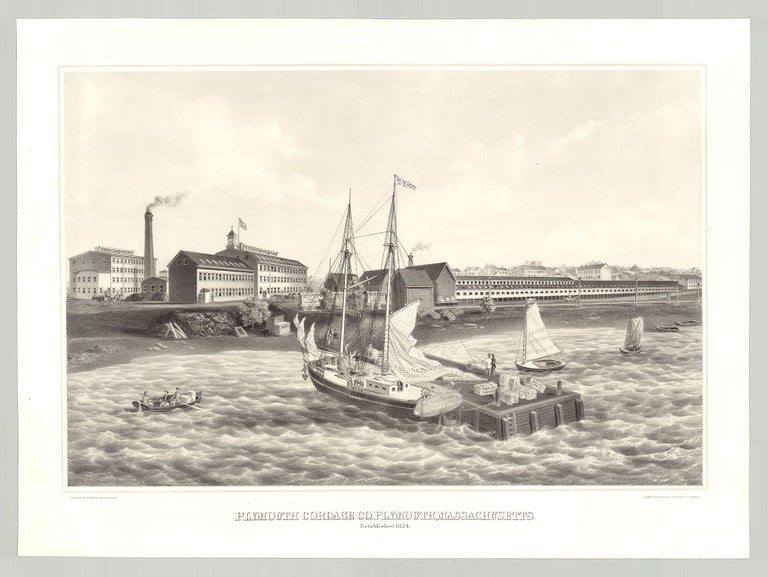Plymouth Cordage Co. Plymouth, Massachusetts. Established 1824.
Boston: Plymouth Cordage Co., [c. 1875]. Printed by Bufford Bros. Tinted lithograph, 17.375” x 26.25” plus margins. A handsome lithograph depicting the Plymouth Cordage Company factory, situated on the waterfront in Plymouth, Massachusetts. Seen here is the company’s complex, including the extensive “ropewalk building” on the right, in which workers assembled great lengths of rope. Freight cars of the Old Colony Line can be seen on the railroad between the factory buildings and the water. In the foreground a shipment of cordage is being loaded from the company pier onto the schooner Mayflower Seaside. Buildings visible in the background likely include housing for workers. The Plymouth Cordage Company of North Plymouth, Mass. was established in 1824 by Bourne Spooner (1790–1870), its large factory situated some two miles north of Plymouth Rock. By the late-nineteenth century, the Company was the world’s largest manufacturer of rope and twine—its products widely used in shipping (for ship rigging) and fishing industries, and its binder twine also widely used in agriculture. Spooner was an abolitionist and believed in free labor, leading him to create innovative, robust employee benefits and facilities for his workers. The land he selected as the location for the Plymouth plant was far removed from housing or transportation. As a result, beginning in 1825 the company started building homes for its employees. Plymouth’s largest employer for over a century, the company started employing women in 1838. The company built a second factory in Welland, Ontario in 1904—the Mayor of Welland hailing the company’s arrival as an important step towards Welland becoming a city. In the early 1900s Plymouth Cordage was chosen among its competitors to manufacture the rope used on the USS Constitution. Bartolomeo Vanzetti (1888–1927)— of the Sacco and Vanzetti case—would briefly work at Plymouth Cordage in the early part of the twentieth century, and Upton Sinclair’s historical novel Boston (1928) (which concerns the Sacco and Vanzetti affair) includes several chapters that feature the company factory. Over its 140 years of operation the company maintained its integrity—seeing only one major strike and acquiring no debt. Plymouth Cordage went out of business in 1964. John Perry Newell (ca. 1831–1898) was born in Newport, Rhode Island and moved to Boston in 1848 to apprentice at J. H. Bufford's lithographic firm. Between 1853 and 1857 Newell travelled between Newport and Boston, composing local views which he drew on stone for Bufford. Newell's early lithographs of the Newport and Providence areas found commercial and popular success. Over the following seven years Newell lithographed views of Massachusetts and Rhode Island towns that also sold well. While Bufford served as Newell’s primary printer over the course of his career, his lithographs were also produced by New England Lithographic Co., Endicott & Co., and Robertson, Seibert & Shearman. Following an influx of affluent residents to Newport in the 1870s, Newell also took up work drawing the new mansions and yachts these residents commissioned. Newell took several trips to Europe during his career and produced lithographic works there. In 1882, he sailed to England where he lived out the rest of his life and continued to work as a lithographer. John Henry Bufford (1810–1870) was born in Portsmouth, New Hampshire and in 1829 began apprenticing as a lithographer with the Pendleton firm in Boston, during the period when American lithography was just starting to become a technique used in commercial printing. Remaining with Pendleton until 1835, Bufford then left to start his own firm in New York. Here he printed book illustrations, sheet music covers, city views, and copies of popular artworks. Bufford also produced prints depicting disastrous fires, and worked as an artist for the Endicott and Currier firms in New York. Upon returning to Boston in 1840, he and his brother-in-law B. W. Thayer and John E. Moody bought out Pendleton, owned by Thomas Moore since 1836. Bufford worked as the primary artist and general manager of the new company, B. W. Thayer & Co., which was one of the first color lithographers in the U.S.—producing work from several stones as early as 1843 or 1844. When Thayer left the company in 1845, the firm became J. H. Bufford & Co. Bufford was one of the most important lithographers in antebellum America—his work encompassing city views, posters, book illustrations, sheet music covers, and prints for framing. Early in their careers, both Winslow Homer and Francis D’Avignon worked for Bufford. In 1865, Bufford's sons Frank and John Henry Jr. became partners in his company. Following their father’s death in 1870, the brothers continued operating the firm until the early 1900s. REFERENCES: Pierce, Sally and Catharina Slautterback. Boston Lithography, 1825-1880 (Boston, 1991), p.178; Last, Jay T. The Color Explosion (Santa Ana, California: Hillcrest Press, 2005), pp. 47-48; About Us at plymouthcordageco.org; Plymouth Cordage Company album at digital.hagley.org; Plymouth Cordage Co., main entrance at digitalcommonwealth.org CONDITION: Very good.
Item #6042
Sold


